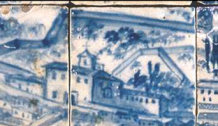
Taken from the Grand Panorama of Lisbon. This part of the image shows where the nuns lived and how it looked before the earthquake. Credit: Museu Nacional do Azulejo, DGPC/Arquivo de Documentação Fotográfica, Carlos Monteiro, 1994
Remarkable letter reveals earthquake drama for nuns in exile
Travelling around Europe in search of a new home after the dissolution of the monasteries must have been dramatic enough for England’s oldest community of Bridgettine nuns. But a remarkable newly-catalogued letter shows they also experienced another harrowing event – the Great Lisbon Earthquake of 1755.
Archivists at the University of Exeter have examined a letter describing the horrific event as part of a project to catalogue and preserve 600 years of archives, manuscripts and books from the community.
Documents in the archive provide incredible insight into the lives of the nuns in exile and the challenges they encountered while living in Lisbon. In 1651, the convent had to be rebuilt after it was destroyed in a fire. In 1695, the last brother of Syon Abbey died and the nuns had many difficulties in finding English-speaking priests to say mass, administer the sacraments, and advise on practical matters. And in 1755, a terrible earthquake struck Lisbon.
The horror of the earthquake is described by one of the nuns, Sister Catherine ‘Kitty’ Witham, in a letter to her mother.
In the letter, written on 27 January 1756, almost two months after the earthquake took place in 1755, Sister Kitty explains how she was washing up the “tea things” when the earthquake – “the Dreadfull Afaire” – began.
Sister Kitty vividly describes the first moments of the earthquake, writing: “itt began like the rattleing of Coaches & the things before me danst up & downe upon the table, I look[e]d A bout me & See the Walls A Shakeing, & a falling down then I up & took to my heells, with Jesus in my mouth, & to the quire I run, thinking to be safe there, but there was no Entranc[e] but all falling round us, & the lime & dust so thick there was no Seeing.”
Sister Kitty writes that the sisters were all alive and well but frightened, and describes how they had to sleep under a pear tree covered with a carpet for eight days before a wooden house could be made in the garden. In addition to describing the destruction to the convent building, Sister Kitty also provides information about the state of the city and its inhabitants. She explains that Lisbon is “Nothing but a heep of Stones Caused by the great fier which burnt for Eeight days” and that the earthquake had resulted in the death of more than 40,000 people. Sister Kitty also recounts stories she has heard regarding the fate of various people in Lisbon, some of whom survived the earthquake and others who tragically lost their lives.
Annie Price, the archivist who catalogued the Syon Abbey archive at the University of Exeter’s Special Collections, said: “This letter is quite remarkable, not only for its evidentiary value as a first-hand account of the earthquake, but also as a tantalising glimpse of a woman’s life as a nun in exile in the eighteenth century. It provides insight into her daily routine, the close bonds she maintained with friends and family back in England, and her emotions in the aftermath of the earthquake. Intriguingly, more traces of Sister Kitty can be found across the Syon Abbey Collection: her vow of profession is kept in the archive, a number of books contain her handwritten inscriptions, and she transcribed several of the manuscripts herself. Sister Kitty’s writing style is vibrant and engaging, and her lasting presence in various written sources within the collection indicate a strong passion for reading and writing.”
Syon Abbey was the only English Catholic religious community to continue existing without interruption following Henry VIII’s Dissolution of the Monasteries. It was founded in Twickenham in 1415 as a monastery of the Order of St Saviour. It accommodated both nuns and monks, and was governed by an abbess. The enclosed community followed the Rule of St Bridget of Sweden and was renowned for its dedication to reading and contemplation.
After the Dissolution of the Monasteries, the community continued its religious practice in smaller groups. Syon Abbey was restored for a short period in England under the rule of Mary I, but when her sister Elizabeth I became queen, the community left England and went into exile. After spending 50 years migrating through the Low Countries and France, the community found a new home in Lisbon in 1594.
Following the Great Lisbon Earthquake, the nuns of Syon Abbey were able to rebuild their convent and continue their religious life in Portugal. The community returned to England in 1861, initially residing in Spetisbury in Dorset. In 1887, the sisters moved to Devon, where they remained for more than century – first in Chudleigh and then from 1925 in South Brent – until 2011, when the decision was made to close Syon Abbey.
The Syon Abbey archive was deposited on loan for safekeeping with Special Collections at the University of Exeter by the remaining Bridgettine nuns of Syon Abbey in 2011, and was catalogued between November 2016 and June 2018. Although Syon Abbey is no longer active, the archive, manuscripts and printed books remain together and collectively form an invaluable resource through which to explore and research Syon Abbey and its history.
Date: 12 March 2019
